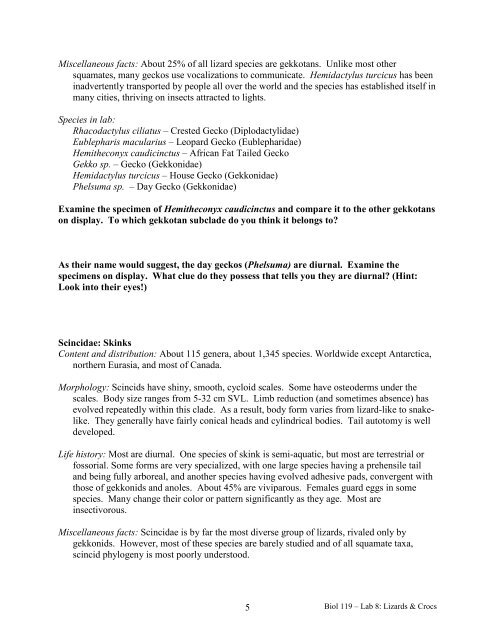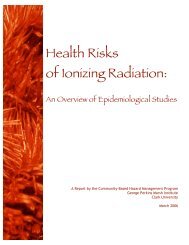Biol 119 – Herpetology Lab 8: Lizard and ... - Clark University
Biol 119 – Herpetology Lab 8: Lizard and ... - Clark University
Biol 119 – Herpetology Lab 8: Lizard and ... - Clark University
You also want an ePaper? Increase the reach of your titles
YUMPU automatically turns print PDFs into web optimized ePapers that Google loves.
Miscellaneous facts: About 25% of all lizard species are gekkotans. Unlike most other<br />
squamates, many geckos use vocalizations to communicate. Hemidactylus turcicus has been<br />
inadvertently transported by people all over the world <strong>and</strong> the species has established itself in<br />
many cities, thriving on insects attracted to lights.<br />
Species in lab:<br />
Rhacodactylus ciliatus <strong>–</strong> Crested Gecko (Diplodactylidae)<br />
Eublepharis macularius <strong>–</strong> Leopard Gecko (Eublepharidae)<br />
Hemitheconyx caudicinctus <strong>–</strong> African Fat Tailed Gecko<br />
Gekko sp. <strong>–</strong> Gecko (Gekkonidae)<br />
Hemidactylus turcicus <strong>–</strong> House Gecko (Gekkonidae)<br />
Phelsuma sp. <strong>–</strong> Day Gecko (Gekkonidae)<br />
Examine the specimen of Hemitheconyx caudicinctus <strong>and</strong> compare it to the other gekkotans<br />
on display. To which gekkotan subclade do you think it belongs to?<br />
As their name would suggest, the day geckos (Phelsuma) are diurnal. Examine the<br />
specimens on display. What clue do they possess that tells you they are diurnal? (Hint:<br />
Look into their eyes!)<br />
Scincidae: Skinks<br />
Content <strong>and</strong> distribution: About 115 genera, about 1,345 species. Worldwide except Antarctica,<br />
northern Eurasia, <strong>and</strong> most of Canada.<br />
Morphology: Scincids have shiny, smooth, cycloid scales. Some have osteoderms under the<br />
scales. Body size ranges from 5-32 cm SVL. Limb reduction (<strong>and</strong> sometimes absence) has<br />
evolved repeatedly within this clade. As a result, body form varies from lizard-like to snakelike.<br />
They generally have fairly conical heads <strong>and</strong> cylindrical bodies. Tail autotomy is well<br />
developed.<br />
Life history: Most are diurnal. One species of skink is semi-aquatic, but most are terrestrial or<br />
fossorial. Some forms are very specialized, with one large species having a prehensile tail<br />
<strong>and</strong> being fully arboreal, <strong>and</strong> another species having evolved adhesive pads, convergent with<br />
those of gekkonids <strong>and</strong> anoles. About 45% are viviparous. Females guard eggs in some<br />
species. Many change their color or pattern significantly as they age. Most are<br />
insectivorous.<br />
Miscellaneous facts: Scincidae is by far the most diverse group of lizards, rivaled only by<br />
gekkonids. However, most of these species are barely studied <strong>and</strong> of all squamate taxa,<br />
scincid phylogeny is most poorly understood.<br />
5<br />
<strong>Biol</strong> <strong>119</strong> <strong>–</strong> <strong>Lab</strong> 8: <strong>Lizard</strong>s & Crocs
















